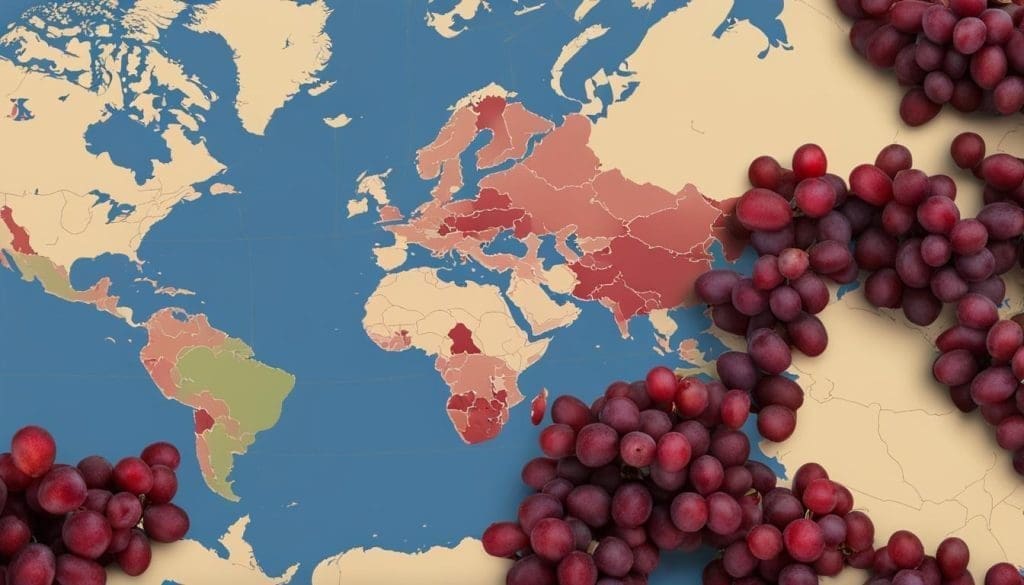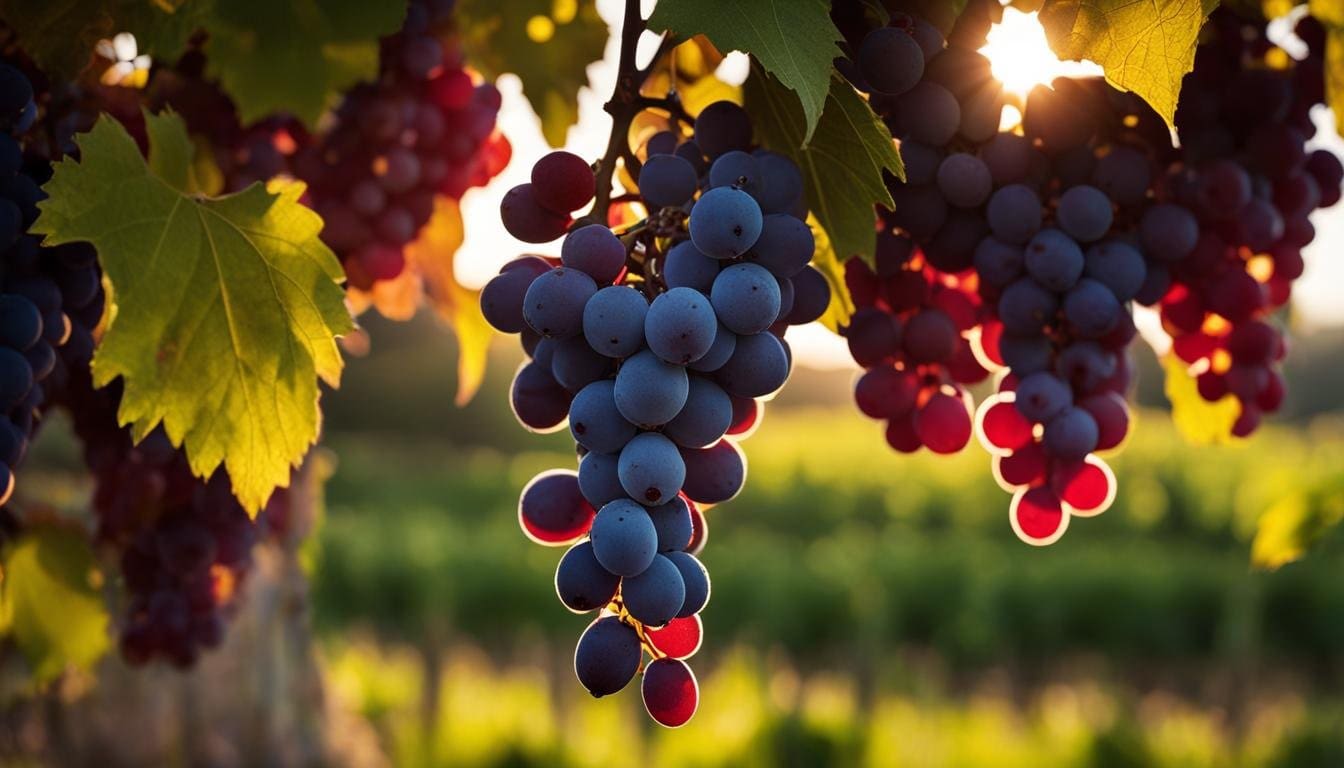This post may contain affiliate links. Please read my disclosure policy.
Pinot Noir, affectionately known as the ‘heartbreak grape’, is a highly regarded and sought-after variety amongst wine aficionados. Its impressive depth and complexity, developed through a combination of primary flavours such as raspberry, cherry, mushroom, vanilla, and hibiscus, have firmly established it as a key player in the world of red wines.
Hailing from cooler climates, Pinot Noir grapes are predominantly grown in France, the USA, Germany, New Zealand, Italy, South Africa and Australia, making it a truly international varietal that is loved by wine enthusiasts across the globe.
Key Takeaways
- Pinot Noir is celebrated for its depth, complexity, and global influence in the red wine industry.
- Common primary flavours in Pinot Noir wines include raspberry, cherry, mushroom, vanilla, and hibiscus.
- Pinot Noir comes from cooler climates and is grown primarily in France, the USA, Germany, New Zealand, Italy, and Australia.
- Wines made from this grape variety are light to medium-bodied with moderate alcohol content.
- Pinot Noir’s taste profile evolves as it ages, developing richer, earthier nuances.
- Wine pairings with Pinot Noir are versatile, including dishes such as salmon, duck, and earthy mushroom recipes.
- Terroir plays an important role in the characteristics and flavour profiles of Pinot Noir wines, with each growing region lending its distinctiveness to the final product.
Unveiling the Mystique of Pinot Noir
Pinot Noir’s mystique comes from its aromatic complexity and the allure of its delicate yet expressive flavour profile. Its esters create an array of flavours from ripe fruits to earthy undertones, evolving into forest floor and leather with age.
Aromas of red fruits are complemented by earthiness, spice, and sometimes smoky notes from oak-aging. It is known for its grace, subtlety, low to moderate tannins, and high acidity, making it a revered grape in the world of red wines.
The Complexity and Allure Behind the World’s Most Sought-After Grape
The beguiling nature of Pinot Noir stems from its unique ability to display an incredible range of flavours and aromas, coupled with an inherent elegance that captivates wine enthusiasts around the globe.
Some of the key factors contributing to the complexity and allure of Pinot Noir include:
- Variability in taste and aroma due to terroir influence
- A diverse range of styles from light and fragrant to rich and structured
- Evolving flavour profile as the wine ages
- The challenge of cultivation, earning it the title of “heartbreak grape”
- An age-worthy wine that offers a unique tasting experience
The diversity in flavour and aroma profile is primarily attributed to the specific terroir in which the grapes are grown, as well as the winemaking techniques employed by each producer. This results in unique Pinot Noir expressions that showcase the versatility and adaptability of this sought-after grape variety.
| Primary Flavours | Secondary Flavours | Tertiary Flavours | Tannin | Acidity |
|---|---|---|---|---|
| Fruits (cherry, raspberry, strawberries) | Spices, earthiness, oak | Forest floor, leather, mushroom | Low to moderate | High |
“Pinot Noir is the most romantic of wines, with so voluptuous a perfume, so sweet an edge, and so powerful a punch that, like falling in love, they make the blood run hot and the soul wax embarrassingly poetic.” – Joel Fleischman, Vanity Fair
The enchanting allure of Pinot Noir has cemented its position as one of the world’s most sought-after grape varieties, captivating the senses and inviting wine drinkers to indulge in its myriad charms.
Origins and Historical Prominence of Pinot Noir
The Pinot Noir origins can be traced back over a thousand years, potentially originating from wild Vitis sylvestris vines. Its ancestral home and the epicentre of its historical prominence is the Burgundy region in France.
As the history of Pinot Noir reveals, this variety not only plays a central role in Burgundy’s red wines but has also spread globally to cooler climates, becoming a crucial component in Champagne and sparkling wine production.
The evolution of Pinot Noir grape has proven to be quite challenging, thanks to its susceptibility to diseases and to the vineyard’s environmental conditions. These factors have earned it the title “heartbreak grape”, representing the reward and risk associated with cultivating this grape variety.
Considering the long and rich history of Pinot Noir, it is important to highlight some key milestones and events that shaped its growth to prominence:
- The origin of Pinot Noir dates back to the Roman era, with documented cultivation taking place in Burgundy as early as the 1st century AD.
- Monks throughout Burgundy played a significant role in cultivating and promoting Pinot Noir during the Middle Ages, further cementing its prominence.
- By the 14th century, Pinot Noir was already widely recognized and regarded as a superior red wine grape in Burgundy and beyond.
- In the 18th century, the cultivation of Pinot Noir expanded beyond Europe to areas such as Africa, Australia, and the Americas.
- Throughout the 20th century, Pinot Noir continued its global expansion in response to increased consumer interest, particularly in regions such as California, Oregon, and New Zealand.
“Winemakers from France to Oregon regard Pinot Noir as the ultimate test of their skill and the pinnacle of their achievement, for it is a grape that responds to a light touch in winemaking but reveals every mistake.”
Nowadays, Pinot Noir is found in a variety of esteemed wine regions worldwide, with each new location contributing its terroir characteristics to the final product. As the story of Pinot Noir’s origins and evolution unfolds, it becomes evident that this grape variety, despite its challenges, has continuously shaped the landscape of red wine production globally.
An Introduction to Pinot Noir Varietal Characteristics
When it comes to the world of red wines, Pinot Noir occupies a special place, owing to its unique varietal characteristics that set it apart from other grapes. Delving into the intricacies of this captivating grape variety, one can better understand its charm and allure.
Pinot Noir is renowned for its thin skins and tightly packed clusters, contributing to its light colour and lower tannin levels.
These factors make the wines light to medium-bodied, with a beautifully diverse range of bouquets. The thinner skin allows for a luminous, nearly transparent red hue, which draws the eye just as much as the captivating flavours draw the palate.
One of the most distinguishing features of Pinot Noir is its complex flavour profiles. The grape’s unique terroir characteristics make it highly expressive, allowing for a wide array of flavours that are reflective of its environment. These include:
- Cherry
- Raspberry
- Strawberry
- Vegetal and “barnyard” notes as it ages
When it comes to Pinot Noir production, the variety is notably less vigorous than its counterparts, making it quite challenging to grow and cultivate. Its smaller leaves and pinecone-shaped grape clusters give it its name, derived from the French words for “pine” and “black.”
The shape of the clusters helps the grapes ripen more evenly, but also makes them susceptible to various diseases, increasing the challenge of producing high-quality Pinot Noir.
| Varietal Characteristic | Description |
|---|---|
| Skin Thickness | Thin |
| Cluster Shape | Pinecone-shaped |
| Colour | Light, translucent red |
| Tannin Levels | Lower |
| Flavour Profiles | Cherry, Raspberry, Strawberry, Vegetal, and “Barnyard” notes |
| Growth Vigour | Less vigorous |
In essence, the varietal characteristics of Pinot Noir contribute significantly to the captivating qualities of the wines produced from this grape. From its alluring appearance to its diverse flavour profiles and challenging cultivation, the journey of Pinot Noir from vineyard to glass is a testament to the passion and dedication of the winemakers preserving the essence of this sophisticated grape.
Pinot Noir’s Signature Flavour Profile
Considered to be one of the most captivating grape varieties, Pinot Noir possesses a unique and enchanting signature flavour profile. The wine’s flavour notes embody a dazzling spectrum of vibrant red fruits through to more nuanced earthy tones. Its taste characteristics are significantly influenced by ageing, often resulting in an enthralling evolution over time. In this section, we will decrypt the palate of Pinot Noir and delve into the effects of ageing on the wine.

Decoding the Palate: From Cherry to Mushroom
Pinot Noir is renowned for its complex flavour profile, offering a delightful array of primary flavours. Ranging from vibrant red fruits such as cherry and raspberry, to more sophisticated notes of mushroom, the taste experience of this varietal is truly unparalleled.
These primary flavours are often accompanied by subtle hints of vanilla and hibiscus, further enhancing the enchanting flavour profile. The origin of the wine and winemaking techniques significantly contribute to shaping these intricate characteristics.
How Age Affects the Taste Characteristics of Pinot Noir
As Pinot Noir ages, its taste characteristics undergo a remarkable transformation. Developing rich, earthy notes akin to a damp forest floor, the wine reveals a completely new aspect of its multifaceted flavour profile. The ageing impact on Pinot Noir results in a graceful evolutionary path, with most varieties maturing ideally over a period of 5-10 years.
Top-tier Pinot Noirs may continue to delight for up to 20 years, presenting enchanting hints of mushroom and leather that add to their complexity and depth.
To navigate the nuances of Pinot Noir and determine whether to drink it now or age it further, consider the following guide:
| Age of Pinot Noir | Taste Characteristics |
|---|---|
| Young (1-4 years) | Primary flavours of red fruits such as cherry, raspberry, and strawberry. Delicate hints of vanilla and hibiscus. |
| Medium-aged (5-10 years) | Development of earthy undertones and forest floor notes. Slight emergence of mushroom and leather. |
| Old (10+ years) | Well-rounded and complex palate with distinct earthy mushroom and leather notes. Subtle fruit flavours weaving throughout. |
When selecting a Pinot Noir, consider the wine’s age and corresponding flavour profile to ensure a truly memorable sensory experience, reflective of the varietal’s captivating signature flavours and ageing potential.
The Art of Serving Pinot Noir: Temperature and Glassware
Pinot Noir, with its exquisite flavour profile and delicate nuances, deserves special attention when it comes to serving. To ensure you make the most of your Pinot Noir experience, it is essential to consider both the serving temperature and the choice of glassware. In this section, we will delve into the optimal conditions to enjoy this captivating red wine.
The ideal temperature for Pinot Noir is slightly cooler than room temperature, best enjoyed between 55-60°F (12-15°C). Serving the wine too warm may cause the delicate flavours to be overpowered by the alcohol and tannins, whereas serving it too cool can mute the wine’s complexity and expressive bouquet. If necessary, you can chill the wine in the refrigerator for about 30 minutes before uncorking it.
Pro Tip: Invest in a wine thermometer to ensure you achieve the perfect serving temperature for Pinot Noir.
Once you have achieved the ideal temperature for serving Pinot Noir, the next consideration is the glassware. For this delicate wine, the recommended glass type is an aroma collector wine glass, also known as a Burgundy glass. This type of glass has a wider, rounder bowl and a narrower rim, allowing the wine’s delicate aromas to gather in the glass, enhancing the drinking experience by optimising the wine’s aromatic profile.
Additionally, decanting Pinot Noir for approximately 30 minutes before serving is recommended. By introducing oxygen, decanting allows the wine to breathe and helps it fully express its flavour complexity, unlocking the subtle nuances and enhancing your overall enjoyment.
- Chill Pinot Noir to the ideal temperature of 55-60°F (12-15°C).
- Choose an aroma collector wine glass (Burgundy glass) for optimal aromatic profile.
- Decant the wine for approximately 30 minutes before serving to enhance the flavour complexity.
In summary, taking the time to prepare and serve Pinot Noir with the appropriate temperature and glassware can significantly elevate its potential and allow the drinker to truly appreciate the many layers of flavours and aromas of this enchanting and enigmatic varietal.
The Global Footprint of Pinot Noir: From Burgundy to the New World
From its origins in Burgundy to its adaptation in the New World, Pinot Noir takes on distinctive characteristics influenced by regional terroir. Regions famed for Pinot Noir, such as France, the United States, Germany, New Zealand, and Australia, each contribute unique flavour profiles ranging from earthy and floral notes in Burgundy to fruit-forward and lush expressions in California and Oregon.
Pinot Noir showcases the diversity of wines possible from a single grape varietal based on climatic conditions, soils, and winemaking practices around the globe.

Region by Region: Exploring the Terroir Influence
Regional influence on Pinot Noir is a critical aspect in understanding the nuances offered by this versatile grape. To provide a comprehensive view of the varied expressions of Pinot Noir, here is a breakdown of some notable growing regions of Pinot Noir:
| Region | Notable Characteristics |
|---|---|
| Burgundy, France | Earthy, floral, and mineral-driven flavours |
| California, United States | Fruit-forward, lush, higher alcohol content |
| Oregon, United States | Elegant, earthy, and balanced in fruit and acidity |
| Baden, Germany | Typically lighter, fruit-driven, and mineral in character |
| Central Otago, New Zealand | Intense fruit flavours, structured tannins, and good acidity |
| Yarra Valley, Australia | Bright red fruit flavours, fresh acidity and well-integrated oak |
While each region offers a distinctive expression of Pinot Noir, it is essential to remember that variations in terroir and winemaking practices within each region can also lead to a wide array of styles and flavours. Aspiring wine connoisseurs and casual wine lovers alike should never underestimate the power of personal exploration in understanding and appreciating the global footprint of Pinot Noir.
Pinot Noir and the Climate Factor
The climate plays a pivotal role in the cultivation and characteristics of Pinot Noir, with the grape preferring intermediate climates with long, cool growing seasons. This varietal is notably finicky, requiring specific conditions found in sheltered valleys or near large bodies of water to thrive and develop its signature flavour profiles.
Understanding the optimal climate conditions for Pinot Noir is essential to producing high-quality wines with the desired characteristics. For instance, cool climates with moderate temperatures promote the development of complex flavours, while warmer temperatures can result in more fruit-forward expressions.
Soil conditions for Pinot Noir also make a significant impact, as well-drained, diverse soils enhance the wine’s inherent traits.
Terroir and Pinot Noir are intrinsically linked, as the climate, soil, topography and other environmental factors contribute to the final product. The following table demonstrates the various climates, regions, and typical flavour profiles associated with Pinot Noir:
| Region | Climate | Typical Flavour Profiles |
|---|---|---|
| Burgundy, France | Cool Continental | Red fruit, earthy, floral, and spice notes |
| Oregon, USA | Moderate Maritime | Bright red fruit, earthy, forest floor, and mushroom |
| California, USA | Mediterranean | Fruit-forward, rich, and lush, with dark fruit notes |
| Central Otago, New Zealand | Cool Continental | Red fruit, floral, and mineral undertones |
| Yarra Valley, Australia | Maritime | Elegant, red and dark fruit, earthy, and spice notes |
As seen in the table, factors such as climate and terroir greatly impact the resulting characteristics of a Pinot Noir wine. Thus, it is evident that a harmonious balance of environmental conditions is crucial for the cultivation and quality of this famed grape variety.
Culinary Companions: Food Pairing with Pinot Noir
Pinot Noir is a versatile wine for food pairings, complementing dishes from salmon to richer meats like duck. Its acidity and complexity make it an excellent match for earthy-fatty dishes, especially those that incorporate mushrooms. Its adaptability as a catch-all pairing wine makes it a go-to choice for diverse menus.
When it comes to food pairings with Pinot Noir, there are endless possibilities for creating an unforgettable dining experience. But, some dishes particularly shine when paired with this delightful red wine. Here are a few delicious cuisine matches for Pinot Noir to consider:

- Grilled Salmon with a herb and citrus marinade
- Slow-cooked Duck Confit with a cherry & red wine reduction
- Earthy Mushroom Risotto with truffle oil & Parmesan
- Rosemary-glazed Lamb Shanks with garlic mashed potatoes
- Roasted Vegetable Medley with thyme & balsamic reduction
Going beyond the traditional food pairings, the wine’s bright acidity and earthy undertones make it a perfect companion for various types of cuisine. Below are some global culinary companions for Pinot Noir:
| Country | Cuisine |
|---|---|
| France | Coq au Vin |
| Italy | Osso Buco |
| Spain | Tapas with Jamón Ibérico and Manchego cheese |
| Japan | Grilled Tuna Tataki with ponzu sauce |
| Thailand | Massaman Curry |
Pinot Noir’s versatility in wine and food pairing allows it to be a go-to choice for a diverse range of dishes and cuisines while accentuating the flavours and enhancing the overall dining experience.
The Science and Romance of Vinification: Making Pinot Noir
In the delicate world of vinification of Pinot Noir, passion and artistry merge with scientific precision to create wines that stand the test of time. As one of the most temperamental grape varietals, making Pinot Noir requires a keen understanding of the vineyard, winemaking techniques, and the intricate balance that reflects the inherent qualities of the grape.
From fermentation to ageing, the science of Pinot Noir production and the romance of Pinot Noir winemaking converge harmoniously to express the winemaker’s vision.
Starting in the vineyard, each cluster of Pinot Noir grapes is carefully picked and sorted to ensure only the highest-quality fruit is processed. Decisions regarding the precise harvest time, crushing methods, and stem inclusion directly impact the final wine’s flavour and body profile.
Once the grapes are processed, fermentation plays a critical role in crafting Pinot Noir. Winemakers can choose between various yeast strains and methods to draw out each unique characteristic of the grape. Temperature control, malolactic fermentation, and even micro-oxygenation become essential variables in bringing out the Pinot Noir’s innate subtleties.
“In winemaking, the devil is in the details, and never more so than with Pinot Noir.”
Ageing is another crucial aspect of making Pinot Noir, where the winemaker showcases their artistic flair. Decisions surrounding the type of oak barrels, the time spent ageing, and the ratio of new to old oak barrels contribute to the finished wine’s flavour profile, tannic structure, and aromatic complexity. Furthermore, the choice of bottling conditions, such as whether to fine or filter the wine, will dictate the wine’s clarity and stability.
- Fermentation: Cultivating the delicate, nuanced flavours of Pinot Noir
- Ageing: Balancing oak influence and grape expression
- Bottling: Final decisions shaping the wine’s character and future
| Stage | Variable | Process |
|---|---|---|
| Fermentation | Yeast Strains | Choosing specific yeasts to enhance particular flavours and aromas |
| Fermentation | Temperature Control | Regulating fermentation temperatures to dictate extraction levels and maintain nuances |
| Ageing | Oak Selection | Determining new and old oak ratios, with varying toast levels to add complexity |
| Bottling | Fining and Filtering | Refining and stabilising the wine, considering clarity and sediment balance |
In conclusion, Pinot Noir vinification marries the intricate knowledge of winemaking with the winemaker’s creative passion. Through attentive and mindful practices, winemakers can fully express the grape’s potential, crafting wines that capture the hearts of wine enthusiasts worldwide.
Notable Pinot Noir Producers and Regions to Explore
The world of Pinot Noir is rich with notable producers and regions worth exploring. From the esteemed vineyards of Burgundy, including Gevrey-Chambertin and Chambolle-Musigny, to the thriving regions of Oregon’s Willamette Valley and California’s Russian River Valley, and the emerging territories in New Zealand and Australia, Pinot Noir showcases its diversity and excellence across the globe. In this section, we will delve into some of the most recognised Pinot Noir producers and their recognitions.

Here is a concise overview of prominent Pinot Noir regions and notable producers that have earned accolades for their exceptional wines.
| Region | Winery/Producer | Award/Recognition |
|---|---|---|
| Burgundy, France | Domaine Armand Rousseau | Gevrey-Chambertin and Grand Cru designations |
| Burgundy, France | Domaine de la Romanée-Conti | Produces the renowned Romanée-Conti Grand Cru |
| Willamette Valley, Oregon | Domaine Drouhin Oregon | Classically-styled Oregon Pinot Noirs |
| Russian River Valley, California | Kosta Browne Winery | Multiple Wine Spectator Top 100 rankings |
| Central Otago, New Zealand | Felton Road Winery | Biodynamic wines with international prestige |
| Yarra Valley, Australia | Giant Steps Winery | James Halliday’s Australian Wine Companion 5-star rating |
As you explore these stellar Pinot Noir regions and producers, you will discover the outstanding diversity in style and flavour profile that this grape can achieve under different terroirs and winemaking techniques.
Whether you prefer elegant and complex wines from Burgundy or fruit-driven and expressive ones from the New World, there is a Pinot Noir out there to captivate your palate and win you over.
Pinot Noir in Pop Culture and Society
Over the years, Pinot Noir has emerged as a significant part of pop culture and society. Its historical roots and role in the world of sparkling wine, particularly Champagne, contribute to its status as a revered and celebrated grape variety.
This section delves into some fascinating aspects of Pinot Noir’s presence in popular culture, how it has influenced culinary trends, winemaking philosophies, and captured the collective imagination of wine enthusiasts.
One interesting aspect of Pinot Noir is that it has over a thousand clones, earning it both admiration and the nickname, “heartbreak grape”. This is due to its susceptibility to vineyard diseases and other implications for those cultivating the grape. Of course, the heartbreak moniker only adds to the mystery, allure, and popularity of this fascinating grape variety.
“This is not Chardonnay, this is not Cabernet. Pinot Noir is the ultimate test of a winemaker’s skill, the masterpiece of the vineyard.” – Winemaking quote expressing the challenge and admiration for Pinot Noir.
Pinot Noir’s impact extends beyond the bottle, and it has seeped into various other realms. Let’s explore how it has influenced culinary trends, winemaking philosophies, and captivated wine lovers:
- Culinary trends: Thanks to its versatile flavour profile, Pinot Noir has become an inspiration in the kitchen, with chefs designing creative dishes to complement the wine. It has resulted in a range of gourmet experiences, encouraging restaurants to create innovative menus that highlight the unique elements of Pinot Noir.
- Winemaking philosophies: As the “diva grape”, Pinot Noir has led to the development of new winemaking techniques and philosophies. Winemakers around the globe continue pushing boundaries to perfect the art of growing and vinifying this challenging and alluring grape variety, shaping the future of the red wine industry.
- Wine enthusiasts: The complexity and charm of Pinot Noir have left a strong impact on wine lovers worldwide. This versatile grape has piqued the interest of collectors, connoisseurs, and enthusiasts, captivating a global audience. It has become a conversation piece at wine tastings and a must-have at any wine enthusiast’s collection.
To sum it up, Pinot Noir has indisputably left its mark on the world of pop culture and society. It has shaped culinary trends, inspired new winemaking techniques, and continues to captivate the hearts and minds of wine enthusiasts.
Conclusion
As a fascinating and ever-evolving grape variety, Pinot Noir captivates wine lovers worldwide with its unique ability to express terroir and the vast complexities of its flavour profile. Its storied history and global footprint have led to the development of an immense range of styles, from delicate and subtle wines to rich and bold expressions.
The versatility of Pinot Noir in food pairings is an added bonus, allowing wine enthusiasts to explore diverse culinary options and enjoy the remarkable harmony generated between wine and dish. This exceptional adaptability in accompaniments also makes it a go-to choice for any occasion.
The allure of Pinot Noir lies in the intricate balance between its challenging cultivation and the romance of transforming it into a delicious, high-quality wine. Winemakers around the world are dedicated to showcasing the best aspects of this “diva grape,” ensuring that Pinot Noir will continue to enchant and inspire wine drinkers for generations to come.
FAQ
What are the primary flavours of Pinot Noir?
Pinot Noir is known for its primary flavours including raspberry, cherry, mushroom, vanilla, and hibiscus. These flavours create a complex taste profile that evolves as the wine ages.
How does the aging process influence the taste characteristics of Pinot Noir?
As Pinot Noir ages, it develops richer, earthy notes resembling a damp forest floor. Mature Pinot Noirs present hints of mushroom and leather that add to the complexity and depth of the wine.
What is the ideal serving temperature for Pinot Noir?
Pinot Noir should be served slightly cooler than room temperature, ideally between 55-60°F (12-15°C).
What type of glassware is recommended for Pinot Noir?
An aroma collector wine glass is recommended for serving Pinot Noir, as it optimises the wine’s aromatic profile and enhances the drinking experience.
Which food pairings work well with Pinot Noir?
Pinot Noir is a versatile wine for food pairings, complementing dishes from salmon to richer meats like duck. Its acidity and complexity make it an excellent match for earthy-fatty dishes, particularly those that incorporate mushrooms.
How does the growing region influence the characteristics of Pinot Noir?
Pinot Noir takes on distinctive characteristics influenced by regional terroir, with regions such as France, the United States, Germany, New Zealand, and Australia each contributing unique flavour profiles ranging from earthy and floral notes in Burgundy to fruit-forward and lush expressions in California and Oregon.
What is the ideal climate for growing Pinot Noir?
Pinot Noir prefers intermediate climates with long, cool growing seasons, requiring specific conditions found in sheltered valleys or near large bodies of water to thrive and develop its signature flavour profiles.
Sip smarter, subscribe now!
Subscribe for gourmet tips, event updates, travel ideas, and a free e-book on Food Pairings. Start your journey to culinary and travel excellence!















